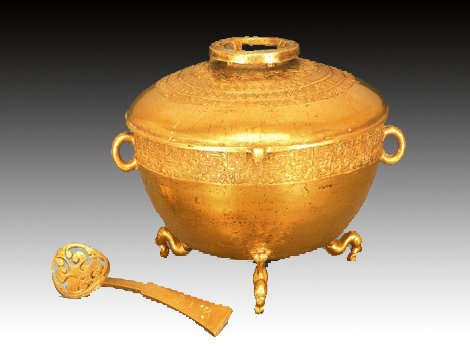
The major methods for processing gold articles originated from bronze making, which include smelting, mould founding, hammering, welding, bead-forming, engraving, wire-drawing, wire-twining, wire inlay, etc., but developed or innovated. Take the bead-forming craft for example. It is an art unique to gold processing in which the first step is to let melted gold drip into warm water drop by drop to form beads of various sizes, and then by welding each tiny drop of gold, fish-egg patterns or bead-string patterns are made. Silverware turned up later than gold, and followed gold articles in working procedures.
From the very beginning gold and silver articles came out as artworks. The existing earliest gold objects were made in the Shang Dynasty more than 3,000 years ago. They were mostly ornaments, simple in shape, small in size, with less decorative patterns. The Shang-dynasty gold articles were chiefly gold and silver foil, gold leaves and sheets, used to adorn utensils; only a few in the northern and northwestern regions were used for personal adornment. Of the earlier gold articles, the gold masks and the gold staffs unearthed from the early Shu-culture ruins in Sanxingdui of Guanghan, Sichuan Province, are the most eye-catching. In the Shang and Zhou dynasties, the bronze techniques and the jade carving both facilitated the growth of gold and silver crafts.
The silver chuwang yi (ladle for dipping water in the shape of a gourd used by the king of the State of Chu) kept in the Palace Museum is one of the earliest silver utensils discovered so far. During the Spring and Autumn and Warring States Period, articles with gold and silver inlay came into view in great quantity, which marked the high technical level of gold crafts at that time. The process of gold and silver inlay started from the mid-Spring and Autumn Period, prevailed in the Warring States Period and gradually went downhill since the Western Han Dynasty. it is one of the ancient fine metal techniques used for adornment. The procedure is to incise patterns or inscriptions on the surface of bronzeware by casting or by chiseling, then have gold and silver wire inlaid, and then grind and polish to produce a decorative effect.
